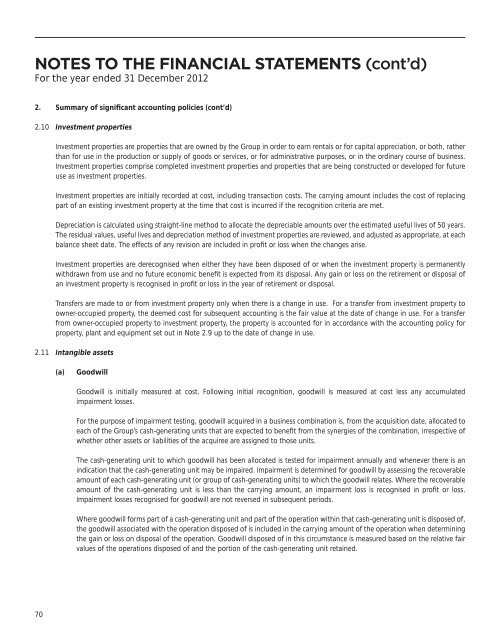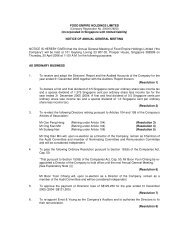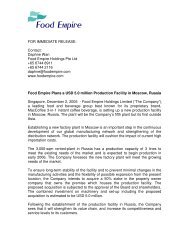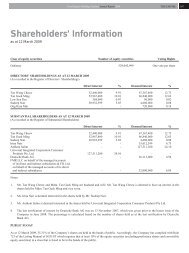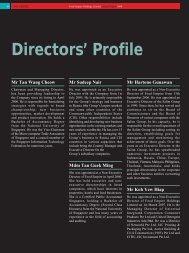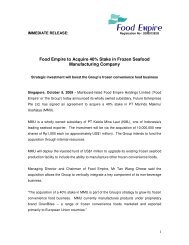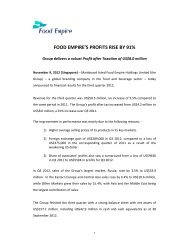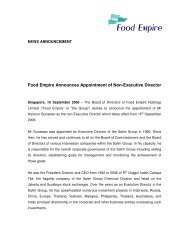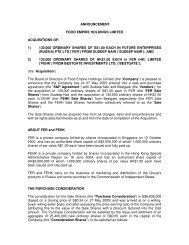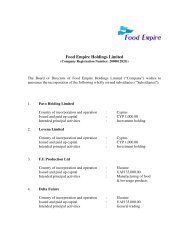notes to the financial statements - Food Empire Holdings Limited
notes to the financial statements - Food Empire Holdings Limited
notes to the financial statements - Food Empire Holdings Limited
You also want an ePaper? Increase the reach of your titles
YUMPU automatically turns print PDFs into web optimized ePapers that Google loves.
NOTES TO THE FINANCIAL STATEMENTS (cont’d)<br />
For <strong>the</strong> year ended 31 December 2012<br />
2. Summary of significant accounting policies (cont’d)<br />
2.10 Investment properties<br />
Investment properties are properties that are owned by <strong>the</strong> Group in order <strong>to</strong> earn rentals or for capital appreciation, or both, ra<strong>the</strong>r<br />
than for use in <strong>the</strong> production or supply of goods or services, or for administrative purposes, or in <strong>the</strong> ordinary course of business.<br />
Investment properties comprise completed investment properties and properties that are being constructed or developed for future<br />
use as investment properties.<br />
Investment properties are initially recorded at cost, including transaction costs. The carrying amount includes <strong>the</strong> cost of replacing<br />
part of an existing investment property at <strong>the</strong> time that cost is incurred if <strong>the</strong> recognition criteria are met.<br />
Depreciation is calculated using straight-line method <strong>to</strong> allocate <strong>the</strong> depreciable amounts over <strong>the</strong> estimated useful lives of 50 years.<br />
The residual values, useful lives and depreciation method of investment properties are reviewed, and adjusted as appropriate, at each<br />
balance sheet date. The effects of any revision are included in profit or loss when <strong>the</strong> changes arise.<br />
Investment properties are derecognised when ei<strong>the</strong>r <strong>the</strong>y have been disposed of or when <strong>the</strong> investment property is permanently<br />
withdrawn from use and no future economic benefit is expected from its disposal. Any gain or loss on <strong>the</strong> retirement or disposal of<br />
an investment property is recognised in profit or loss in <strong>the</strong> year of retirement or disposal.<br />
Transfers are made <strong>to</strong> or from investment property only when <strong>the</strong>re is a change in use. For a transfer from investment property <strong>to</strong><br />
owner-occupied property, <strong>the</strong> deemed cost for subsequent accounting is <strong>the</strong> fair value at <strong>the</strong> date of change in use. For a transfer<br />
from owner-occupied property <strong>to</strong> investment property, <strong>the</strong> property is accounted for in accordance with <strong>the</strong> accounting policy for<br />
property, plant and equipment set out in Note 2.9 up <strong>to</strong> <strong>the</strong> date of change in use.<br />
2.11 Intangible assets<br />
(a)<br />
Goodwill<br />
Goodwill is initially measured at cost. Following initial recognition, goodwill is measured at cost less any accumulated<br />
impairment losses.<br />
For <strong>the</strong> purpose of impairment testing, goodwill acquired in a business combination is, from <strong>the</strong> acquisition date, allocated <strong>to</strong><br />
each of <strong>the</strong> Group’s cash-generating units that are expected <strong>to</strong> benefit from <strong>the</strong> synergies of <strong>the</strong> combination, irrespective of<br />
whe<strong>the</strong>r o<strong>the</strong>r assets or liabilities of <strong>the</strong> acquiree are assigned <strong>to</strong> those units.<br />
The cash-generating unit <strong>to</strong> which goodwill has been allocated is tested for impairment annually and whenever <strong>the</strong>re is an<br />
indication that <strong>the</strong> cash-generating unit may be impaired. Impairment is determined for goodwill by assessing <strong>the</strong> recoverable<br />
amount of each cash-generating unit (or group of cash-generating units) <strong>to</strong> which <strong>the</strong> goodwill relates. Where <strong>the</strong> recoverable<br />
amount of <strong>the</strong> cash-generating unit is less than <strong>the</strong> carrying amount, an impairment loss is recognised in profit or loss.<br />
Impairment losses recognised for goodwill are not reversed in subsequent periods.<br />
Where goodwill forms part of a cash-generating unit and part of <strong>the</strong> operation within that cash-generating unit is disposed of,<br />
<strong>the</strong> goodwill associated with <strong>the</strong> operation disposed of is included in <strong>the</strong> carrying amount of <strong>the</strong> operation when determining<br />
<strong>the</strong> gain or loss on disposal of <strong>the</strong> operation. Goodwill disposed of in this circumstance is measured based on <strong>the</strong> relative fair<br />
values of <strong>the</strong> operations disposed of and <strong>the</strong> portion of <strong>the</strong> cash-generating unit retained.<br />
70


